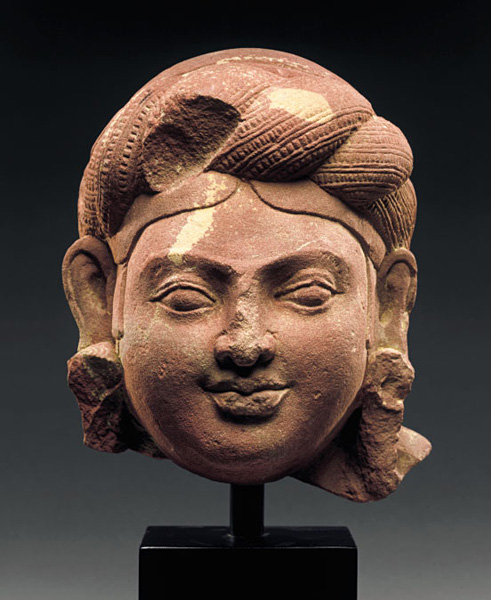|

This head originally must have belonged to a life size figure of a yakshi or a tutelary goddess that stood in a village or town shrine. Yakshis are generally regarded as fertility goddesses, female nature spirits who are associated with trees and lotuses. Their images were often located at entrances to sacred places. Yakshis are also regarded to be the female counterpart of the Yakshas, the guardians of the earth’s treasures, with Kubera as the most popular lord of them all.
Distinguished by a round face, the goddess has wide open eyes with unmarked pupils and faintly ridged lines of the eyebrows. The distinctive hairstyle comprises of rolls of braided hair bound by cords. The veil that covers the hair is carefully folded and pleated behind, and the edge outlined in three grooves, closely moulded to the rolling contours of the hair beneath. The nose and the mouth are of a small compact form, and the ears are slightly protruding. Part of an amphora or disc shaped ear-ornament with a design of concentric rings is depicted on the right ear of the female head.
The head belongs to a group of early sculptures from Mathura which can be dated towards the beginning of the Kushan period, circa 100 A.D. The Kushans were among the most powerful tribes originating from Central Asia. They first conquered Bactria and then moved south into India during the first century. At the height of its power, the Kushan empire stretched from Central Asia in the north to the Deccan in the south and as far east as Bihar. Of the important capitals founded in this classical period, Mathura was functioning as the main centre, wielding the political power of the Kushans until the mid of the third century.
Typical stylistic characteristics of the period are the distinctive hairstyle with rolls of braided hair bound by cords, the veil that covers the hair, and the wide open eyes with unmarked pupils. The small mouth has a smiling countenance, the nose is of a compact form, and the slightly protruding ears include a disc shaped ear-ornament with a design of concentric rings. These features and the use of mottled red sandstone are in addition typical of the period. The earring reflects a Hellenistic influence, and one is worn by the female figure holding a palm on the Cleveland stone pillar with a bacchanalian scene taken from Hellenistic art (see Czuma S. Kushan sculpture images from early India, no 42). The head also bears close resemblance in several details to the head of a male figure in the Mathura museum, which is also carved in the round as a free standing figure and carved from a similar slightly porous red sandstone. The shape of the face, the open eyes and the line of the eyebrow are very similar; heavenly ribbed, usually individually, and with the same expression.
This well preserved head is a classic example of early Indian art and is among the very rare examples in western collections. The sensitive carving exhibits a beautiful volume, pure lines and finely articulated facial features, enhancing the lively and aristocratic expression of the goddess. The elegant coiffure comprises of a superbly carved veil that covers the hair, closely moulded to the rolling contours of the hair beneath. The convincing presence and physical charm reveal the great artistic inspirations of early Indian craftsmen, making this female head a wonderful sculpture of the early Kushan period.
Provenance: Private collection, London.
|

